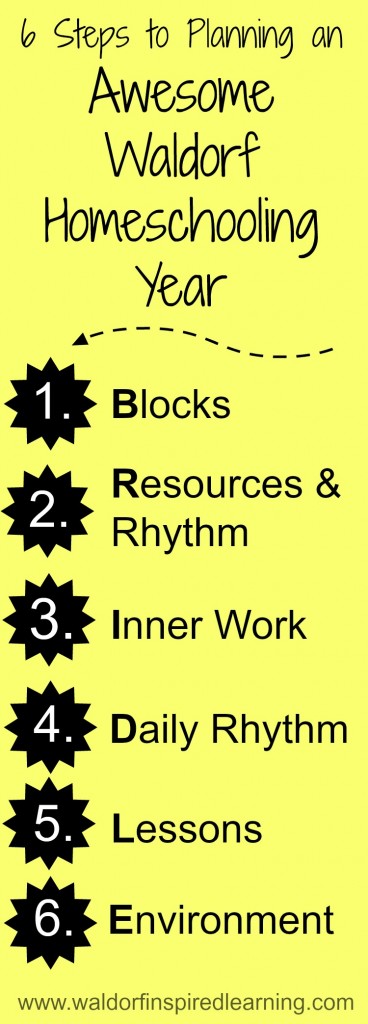Really, no matter what resources or packaged curriculum we may choose to buy, we each create our own curriculum because we will never use a curriculum exactly as is. We aren’t even meant to, actually, because curriculum writers want to include multiple options. This fact that is both daunting and freeing at the same time!
 So, how do we go about creating that curriculum? It all starts with daily rhythm in Waldorf homeschool.
So, how do we go about creating that curriculum? It all starts with daily rhythm in Waldorf homeschool.
Step Four: Daily Rhythm
Daily Rhythm is Step Four in this series, 6 Steps to Planning an Awesome Waldorf Homeschooling Year.
If you want more help plus visual examples, check out my free guide, Homeschool Rhythm Starter Kit: 3 Steps to Rescue Your Rhythm for a Simple Happy Homeschool.
I invite you to picture a beautiful heart in your mind. It represents love but it also represents the rhythm of our heartbeat. Rhythm is “a strong, regular, repeated pattern of movement or sound.”
Steady rhythm can be a steady beat, recurring sound, or a repetitive activity. We can think of not only our heartbeat but also our breath, in and out. These are natural rhythms that live inside our bodies.
Rhythm is the reason why Rudolf Steiner suggested warming up at the start of our lessons with verse recitation, speech exercises, or singing; they all help to regulate our breathing and bring our breath into a steadier rhythm.
Steiner began each of his lectures to the very first Waldorf teachers-in-training with speech exercises and verse recitation to help regulate everyone’s breathing. He said that speech exercises teach us flexibility!
We can find rhythms outside of our bodies, too. There is the rhythm of day and night, the rhythm of the days of the week, the rhythm of the months, and the rhythm of the seasons.
All of these rhythms are a part of our lives and their repetition brings us comfort because they are regular and expected. Rhythm provides an anchor and helps us, and especially helps children who have little control over their environments, to feel secure.
In Step One of this planning process, we looked at the rhythm of the year by thinking in terms of doing a block of learning per month.
In Step Two, we looked at the rhythm of the seasons and the rhythm of the week, where each weekday has a different flavor and often different activities. Like pizza on Saturday nights, or errands and grocery shopping on Thursday afternoons after lunch. Those are rhythms, activities that we do regularly and repeatedly. They are not necessarily assigned a particular time, but more of a general time slot or in relation to another activity.
So here in Step Four, we are ready to look at our Daily Rhythm. This will form the foundation of your homeschooling days and is an important concept to understand.
Want me to take you through this process step-by-step? Check out my online course, Plan It Out.
Take Action: First of all, back in Step Two, you decided how many days a week you will do lessons (so that you could count how many days you will be teaching each block, remember?).
Now you will create a rhythm for those main lesson days.
Start by thinking of what you need to do before your children get up and ready for the day. Make a list of this morning routine somewhere – in your planner, on a post-it note on your bathroom mirror…wherever makes the most sense to you.
Next, make a list of what you and your children will do together. For many families, this is morning time. On this list, you can include breakfast, chore time, circle time, lesson time, outdoor time…you can even include the specific steps of lesson time if you wish.
And finally, I encourage you to make some kind of visual of this daily rhythm. No need to get too elaborate, but it really helps to create something visual and colorful to hang up for everyone in the family to see.
What questions come up for you in creating your daily rhythm?
What suggestions do you have based on your family’s experience with rhythm?
Previous steps:
Next Time, Step Five: Lesson Planning




7 Comments